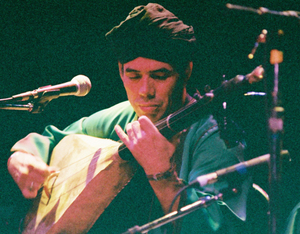We need this; thanks be to UCLA Live's sensitive programming. Nothing wrong with machine beats, syntho-trances and huggy drugs, but nightclub imitations can’t get inside your corpuscles the way Moroccan drummers and hornmen can. The music’s in their genes, and they’ve been making souls dance since Alexander was Average.
There were only eight of ‘em, not the 20 advertised -- a larger contingent appeared at this venue over a decade ago, and the mass does make a difference. Maybe the shortfall had something to do with the visa wrangles to which group leader Bachir Attar alluded at the beginning of the night, though evidence suggests that the MMJ tour force lately has consisted of no more than 10 slavering, bomb-smuggling terrorists. Anyway, they were inspiring.
In the beginning. The ghaitas (oboes) squalled out, drumsticks punished skins, and listener heads started jerking around. The youngest drummer (around 40) wailed with his whole arm, while the older ones conserved energy with a more relaxed wrist action. The ghaita players created vibrato by holding a long note and using a free hand to fan the air directly above the horn. This riff-fugue opening number acted as a sense-shocker, jerking the audience alert for the hour-and-a-half onslaught. Few of us were moving much -- yet.
Bachir whipped out his pear-shaped tenor gimbri -- its stretched skin gave its strings a deep resonance halfway between a drum and a banjo -- and plucked a hot duet with a violinist, who bowed the fiddle while propping it upright on his knee. Six drummers thwapped along, the youngest one cutting loose with a piercing voice that contrasted with the chestier moan we usually heard from Bachir. Soon one of the older gents got up from his chair and added some party-boy levity to the proceedings by prancing around, naughtily lifting up his hem and luring a young woman to skip from the audience and execute sinuous moves in front of the stage.
That and a switch to surging drum polyrhythms broke the ice, and the audience started clapping along as the intensity rose. Bachir took a chat break to explain that he and his gang were just ordinary folks, and say hey, if you’ve got the moon, who needs stars? “We are not stars. No!” Dunno if he was aware that Helen Hunt was among the attendees.
The MMJ grabbed wooden flutes for the evening’s next segment, their drones and curlicue improvisations generating smoky textures that interwove with the rising scent of incense coming from somewhere. The ghaitas came back with overlapping lines; they produced a spatial effect, as if bouncing around inside your cranium, maybe what Ornette Coleman meant by “Dancing in Your Head.” The beats were really driving now, the musicians had stood up to blow harder, most everybody in the hall was clapping, and quite a few piled down front to challenge the fire-lane-conscious staff. The music demanded movement and heavy breathing, an aerobic benefit enhancing the atmosphere of spirit communion -- I noticed that the most natural motion was a rhythmic bowing, the kind of thing that in temple you’d call davening.
Bachir and his most generously proportioned bandmate locked into fast ghaita unisons, jumping registers now and then into high, pained sacrificial-goat bleats. Near the climax, the musicians’ energy loosened and broke in waves against the crowd’s frenzy . . . well, it was about as close to frenzy as a largely middle-aged American mob gets.
The volume had increased substantially, but after the eight stood up and stepped forward, they weren’t blowing into microphones anymore. I don’t know how they did that. But they know.
Read my review of the new MMJ album here.

